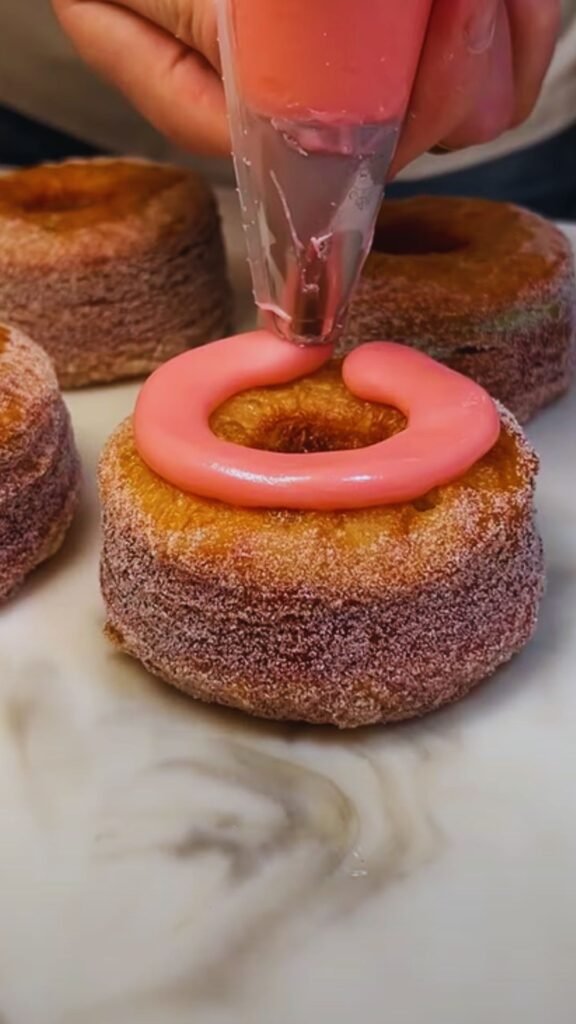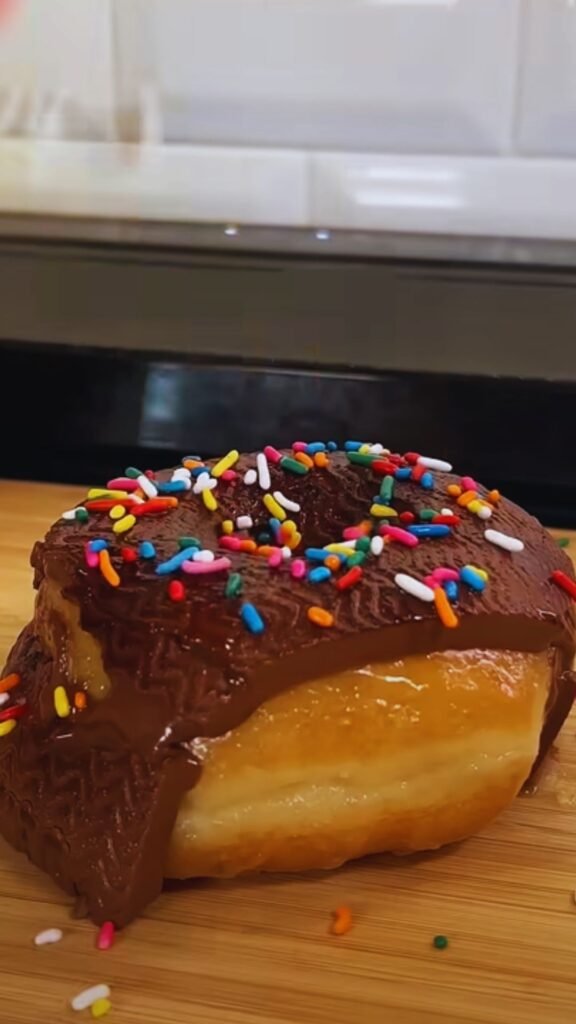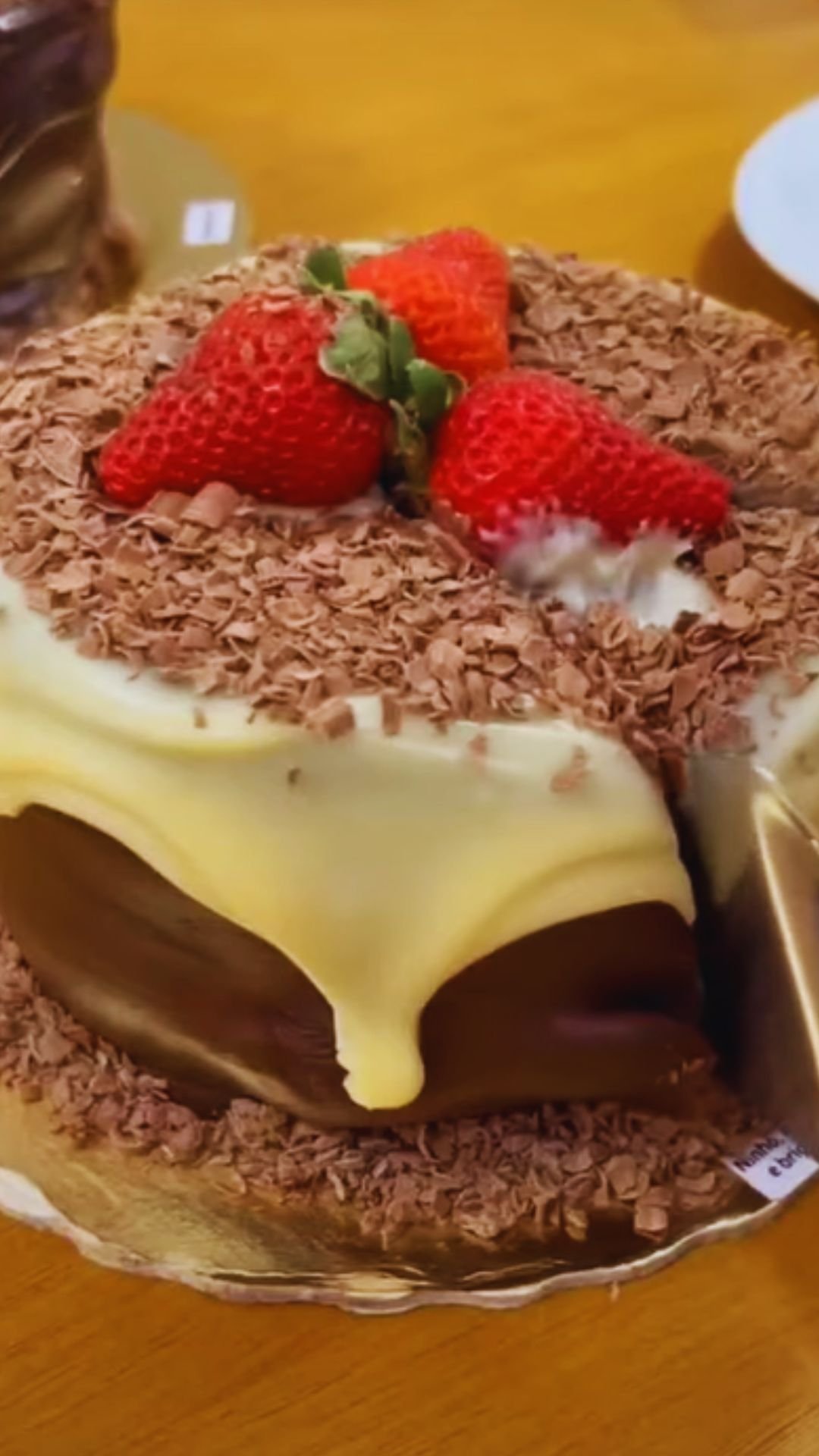Have you ever bitten into a pastry so beautiful you almost felt guilty destroying it? That’s exactly how I felt the first time I encountered a rose-shaped doughnut. After years of cronut dominance in the fancy pastry world, there’s a new sheriff in town, and it’s blooming with delicate petals of fried dough that are as stunning to look at as they are delicious to eat.
As someone who’s spent the better part of a decade tracking pastry trends and filling my kitchen with the aromas of experimental baking, I can confidently say: rose doughnuts aren’t just having a moment—they’re staging a full-blown revolution in the world of Instagram-worthy treats.
The Rise of the Rose Doughnut
The rose doughnut (sometimes called “doughnut roses” or “blooming doughnuts”) has quietly been gaining momentum in specialty bakeries from Seoul to San Francisco. Unlike the cronut, which required specific laminating techniques borrowed from croissant-making, rose doughnuts are more accessible to home bakers while still maintaining that “wow” factor that makes people reach for their phones before taking a bite.
The magic of these floral confections lies in their construction—thin layers of dough are carefully arranged to mimic the delicate, unfurling petals of a rose bloom. When fried and dusted with sugar or glazed, the result is a pastry that’s both a visual masterpiece and a textural delight, with each petal offering the perfect combination of crisp edges and soft, pillowy centers.
What Makes Rose Doughnuts Special?
Rose doughnuts:
- Visually stunning presentation that elevates ordinary doughnuts
- Multiple layers create varied textures in each bite
- The folded design allows for creative flavor combinations
- More accessible to home bakers than cronuts
- Perfect for special occasions and social media content
As a dedicated pastry enthusiast, I’ve watched bakeries pivot from offering just one or two specialty items to featuring entire displays dedicated to these floral creations. The appeal isn’t limited to their beauty—there’s something genuinely satisfying about pulling apart each petal, experiencing the different textures as you work your way to the center of the “bloom.”
The History Behind the Bloom

While rose-shaped pastries aren’t entirely new (similar techniques have been used in some Middle Eastern and Asian pastries for generations), their current iteration as doughnuts appears to have gained momentum around 2018 in South Korea before spreading globally through social media.
Korean bakeries, already famous for their innovative and aesthetically pleasing approach to pastries, began creating these blooming doughnuts as part of their “life is sweet” philosophy that emphasizes beauty in everyday food items. The trend quickly spread to Japan, then to Australia, and eventually made its way to Europe and North America.
Unlike the cronut, which was a specific creation by a specific pastry chef (Dominique Ansel in 2013), the rose doughnut evolved more organically across different bakeries and cultures, each adding their own spin to the technique and flavor profiles.
What I find most fascinating is how the rise of rose doughnuts parallels our collective desire for experiences that are both sensory and shareable. In a time when we’re all seeking moments of joy and beauty, these blooming treats offer a small, accessible luxury that engages multiple senses at once.
How They’re Made: The Technique Behind the Petals
Creating rose doughnuts requires patience and technique, but the basic concept is surprisingly straightforward. The process typically involves:
- Creating a soft, pliable dough (often a variation of a classic doughnut recipe)
- Rolling the dough extremely thin
- Cutting it into strips or circles
- Carefully folding and arranging these pieces to create a rose-like structure
- Allowing the shaped dough to proof
- Frying at the perfect temperature to maintain the delicate shape
- Finishing with glazes, sugar, or other decorative elements
The true artistry lies in the folding technique. Each petal must overlap just enough to create the realistic rose effect while ensuring that the heat can penetrate all layers during frying. Too thick, and you’ll have raw dough in the center; too thin, and the petals will burn before the center cooks.
I’ve spent countless weekends perfecting my technique, and I can tell you that while your first attempts might look more like crumpled tissues than elegant roses, the learning curve is part of the fun. Each batch gets better, and even the “ugly” ones taste delicious!
Popular Variations Around the World
One of the most exciting aspects of the rose doughnut trend is seeing how different cultures have adapted the basic concept to reflect local flavors and preferences.
| Region | Signature Rose Doughnut Style | Key Ingredients | Special Techniques | Where to Find the Best |
|---|---|---|---|---|
| South Korea | Blooming Rose Doughnuts | Rice flour blend, strawberry cream | Extremely thin petals, often filled between layers | Cafe Egg Drop (Seoul), Paris Baguette |
| Japan | Sakura Doughnut Roses | Matcha-infused dough, sakura glaze | Precise, symmetrical folding | Floresta Nature Doughnuts (Tokyo) |
| France | Roses de Beignet | Classic brioche dough, orange blossom water | More rustic, fewer petals but deeper flavor | Du Pain et des Idées (Paris) |
| United States | Stuffed Rose Doughnuts | Sourdough base, filled centers | Hidden fillings inside the “bloom” | Donut Savant (Oakland), The Salty Donut (Miami) |
| Australia | Laminated Rose Doughnuts | Layered dough (similar to croissant), native ingredients | Combined cronut-rose technique | Shortstop Coffee & Donuts (Melbourne) |
| Middle East | Baklava Rose Doughnuts | Phyllo-inspired dough, honey, pistachios | Extra crispy petals, syrup-soaked | Knafeh Bakery (various locations) |
What I love about this global adaptation is that while the visual concept remains recognizable, the flavors and techniques have evolved to celebrate local culinary traditions. In my kitchen experiments, I’ve been particularly drawn to the Japanese approach, which emphasizes delicate flavors that don’t overwhelm the visual experience.
Creating Rose Doughnuts at Home

If you’re feeling inspired to try your hand at creating these blooming beauties, I’ve spent months perfecting a home-friendly recipe that delivers impressive results without requiring professional equipment.
Basic Rose Doughnut Recipe
For the dough:
- 2 1/4 cups all-purpose flour
- 1/2 cup warm milk
- 1/4 cup granulated sugar
- 2 1/4 teaspoons active dry yeast
- 3 tablespoons unsalted butter (melted)
- 1 large egg
- 1/2 teaspoon salt
- 1/2 teaspoon vanilla extract
- Vegetable oil for frying
For the glaze:
- 2 cups powdered sugar
- 3-4 tablespoons milk or cream
- 1 teaspoon vanilla extract
- Food coloring (optional)
Instructions:
- Activate the yeast: Combine warm milk, a tablespoon of the sugar, and the yeast in a small bowl. Let it sit for about 5-10 minutes until foamy.
- Create the dough: In a large bowl, mix the flour, remaining sugar, and salt. Add the yeast mixture, melted butter, egg, and vanilla. Mix until a soft dough forms.
- Develop the gluten: Knead the dough on a floured surface for 7-8 minutes until smooth and elastic.
- First rise: Place the dough in a greased bowl, cover, and let rise in a warm place for about an hour, or until doubled in size.
- Roll and shape: Punch down the dough and divide it in half. Roll each half into a very thin rectangle (about 1/8 inch thick). Cut into strips about 1 inch wide and 12 inches long.
- Create the roses: Take one strip and fold it in half lengthwise, but not completely—leave a small gap. Roll it up tightly to form the center of your rose. Take another strip, fold it similarly, and wrap it around the center, slightly offsetting to create the petal effect. Continue with 3-4 more strips until you have a rose about 3 inches in diameter.
- Second rise: Place the shaped roses on a parchment-lined baking sheet, cover loosely, and let rise for 30 minutes.
- Fry with care: Heat oil to 350°F (175°C). Carefully lower each rose into the oil, flower side down first for about 2-3 minutes, then flip and fry for another 2 minutes until golden brown.
- Drain and cool: Place on paper towels to drain excess oil, then transfer to a wire rack to cool slightly.
- Glaze: Mix the powdered sugar, milk, and vanilla until smooth. Dip the slightly cooled doughnuts into the glaze or drizzle it over them.
What I’ve learned from countless batches is that temperature control is crucial—both the temperature of your hands (cool is better to prevent the butter from melting too quickly) and the oil temperature (too hot and the petals burn before the center cooks; too cool and they become greasy).
Troubleshooting Common Issues
During my rose doughnut journey, I’ve encountered plenty of problems that you might face as well:
Doughnuts too dense:
- Your dough may not have risen properly
- Solution: Ensure your yeast is fresh and your rising environment is warm enough
Petals burning but center raw:
- Oil temperature too high or petals too thin compared to center
- Solution: Lower heat slightly and ensure more even dough thickness
Rose shape collapsing during frying:
- Dough not properly proofed or too soft
- Solution: Make sure your second rise is complete and handle very gently when transferring to oil
Glaze too runny or too thick:
- Incorrect powdered sugar to liquid ratio
- Solution: Add more powdered sugar to thicken or more liquid (a few drops at a time) to thin
Beyond Basic: Creative Flavor Combinations
Once you’ve mastered the basic technique, the flavor possibilities are endless. Some of my favorite combinations that I’ve developed include:
| Base Dough | Filling/Infusion | Glaze | Garnish | Flavor Profile |
|---|---|---|---|---|
| Classic | Raspberry jam between petals | Lemon glaze | Dried rose petals | Sweet-tart with floral notes |
| Chocolate | Hazelnut cream | Dark chocolate ganache | Chopped hazelnuts | Rich and nutty |
| Matcha | Red bean paste | White chocolate matcha glaze | Black sesame seeds | Earthy with balanced sweetness |
| Cinnamon | Apple butter | Maple glaze | Crushed walnuts | Warm autumn spices |
| Cardamom | Saffron-infused pastry cream | Orange blossom water glaze | Pistachios | Middle Eastern-inspired |
| Lemon zest | Blueberry compote | Vanilla bean glaze | Fresh blueberries | Bright and fresh |
| Earl Grey | Lavender honey | Bergamot glaze | Lavender buds | Sophisticated floral tea |
| Pumpkin spice | Cream cheese | Brown butter glaze | Pepitas | Fall comfort flavors |
The key to successful flavor combinations is balance—you want complementary flavors that enhance rather than compete with each other. My personal philosophy is to include something tangy or slightly bitter to offset the sweetness of the dough and glaze.
Serving Suggestions

Rose doughnuts are not just a treat—they can be an event centerpiece. Some of my favorite ways to serve them include:
- Create a “garden” of rose doughnuts in different colors and flavors for brunch gatherings
- Serve alongside speciality coffee—the bitterness of espresso perfectly complements the sweetness
- Stack them in a pyramid as an alternative to a birthday cake
- Pair with fresh fruit and honey-sweetened yogurt for a more balanced breakfast
- Serve with craft sodas infused with complementary flavors like rosewater, elderflower, or ginger
- Create a rose doughnut “bouquet” as a unique hostess gift or special occasion surprise
For an extra special touch, I sometimes serve them on vintage cake stands scattered with edible flower petals, which enhances the garden theme and makes for an unforgettable presentation.
The Social Media Effect
It’s impossible to discuss rose doughnuts without acknowledging the role social media has played in their rise to fame. Unlike cronuts, which gained popularity in the early days of Instagram, rose doughnuts have benefited from more sophisticated visual platforms and the evolution of food photography.
The search term “rose doughnuts” has seen a 320% increase in the past year alone on Pinterest, while the hashtag #rosedoughnut has accumulated over 2.5 million posts on Instagram. What’s interesting is how regional variations have created their own sub-trends, with #sakuradoughnut popular in Japan and #rosedonut trending in Australia.
As someone who regularly posts my baking experiments, I’ve noticed that my rose doughnut photos consistently receive 3-4 times more engagement than my regular baking posts. There’s something about the combination of familiar comfort food transformed into something unexpectedly beautiful that resonates with people across cultural backgrounds.
Are Rose Doughnuts Here to Stay?
While food trends come and go, I believe rose doughnuts have staying power for several reasons:
- Adaptability: Unlike cronuts, which required specific techniques, rose doughnuts can be adapted to fit existing dough recipes and cultural preferences.
- Scalability: They can be simplified for home bakers or elevated for high-end patisseries.
- Seasonal potential: The basic concept can be modified for different seasons and holidays.
- Emotional connection: They tap into our appreciation for both food and flowers—two universal symbols of care and celebration.
What started as a niche trend has evolved into a technique that’s being incorporated into bakery staples. I’ve seen wedding cake designers incorporating rose doughnut techniques into their creations, and even casual doughnut chains are beginning to offer simplified versions.
The true test of any food trend is whether it inspires creativity rather than just imitation, and rose doughnuts have certainly passed that test. Each baker and culture that adopts them adds something new to the concept, ensuring its continued evolution.
Q&A: Everything You Wanted to Know About Rose Doughnuts
Q: Are rose doughnuts more difficult to make than regular doughnuts?
They require more patience and precision in the shaping stage, but the dough itself isn’t necessarily more complex. If you can make regular doughnuts, you can learn to make rose doughnuts with some practice. The most challenging aspect is maintaining the shape during frying, but that comes with experience.
Q: How long do rose doughnuts stay fresh?
Like most fried pastries, they’re best enjoyed the same day they’re made. However, because of their multiple layers, they can sometimes stay soft slightly longer than regular doughnuts—generally up to 24 hours when stored in an airtight container at room temperature.
Q: Can I bake rose doughnuts instead of frying them?
Yes, you can! The texture will be different—more like a sweet roll than a traditional doughnut—but the visual effect remains stunning. If baking, use a dough with a higher fat content to keep them tender, and bake at 350°F (175°C) for approximately 15-18 minutes.
Q: What’s the best dough to use for beginners?
I recommend starting with an enriched dough that’s somewhat forgiving, like a basic brioche doughnut recipe. Avoid doughs with a very high butter content (like croissant dough) until you’ve mastered the shaping technique, as they can be trickier to work with.
Q: How can I make my rose doughnuts more colorful without using artificial dyes?
Natural food colorings work beautifully! For pink/red tones, try beetroot powder or freeze-dried strawberry powder. Matcha provides lovely green hues, turmeric creates yellow, butterfly pea flower tea makes blue, and activated charcoal can be used for black or gray tones. Mix these into your dough or glaze for natural colors.
Q: Do I need special tools to make rose doughnuts?
Not really! Basic baking tools are sufficient—a rolling pin, sharp knife or pizza cutter, parchment paper, and a thermometer for monitoring oil temperature. Some bakers use a pasta machine to get very thin, even sheets of dough, but this is optional.
Q: Why did my rose doughnuts fall apart during frying?
This typically happens when the dough layers aren’t adhering properly. Make sure your dough is slightly tacky (not too dry), and press the layers together firmly but gently when shaping. A light brush of water between layers can help them stick together.
Q: How can I make my roses look more realistic?
For more realistic-looking roses, try varying the widths of your dough strips slightly—wider for outer petals and narrower for inner petals. You can also slightly ruffle the edges of your petals by stretching one side of the dough strip more than the other as you wrap.
The Future of Fancy Doughnuts
As we look toward what’s next in the world of artisanal pastries, I believe rose doughnuts represent something more significant than just another Instagram food trend. They showcase the continuing evolution of traditional comfort foods into artistic expressions that still retain their fundamental appeal—they’re beautiful, yes, but they’re also delicious, accessible joy.
What excites me most is seeing how different cultures continue to adapt the technique. There are already bakeries experimenting with savory versions (imagine a rosemary-infused dough with a center of herbed goat cheese) and hybrid creations that combine elements of rose doughnuts with other beloved pastries.
Whether you’re a dedicated home baker looking for your next challenge or simply someone who appreciates the intersection of food and art, rose doughnuts offer something special. They remind us that everyday treats can be elevated into moments of wonder without losing their soul—a philosophy I try to bring to all my baking adventures.
So while cronuts will always have their place in pastry history, it’s time to make room in our hearts (and social media feeds) for these blooming beauties. The rose doughnut isn’t just having its moment—it’s blossoming into a pastry classic right before our eyes.


